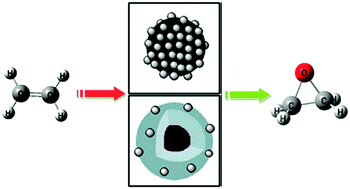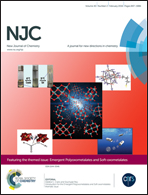Immobilization of a molybdenum complex on the surface of magnetic nanoparticles for the catalytic epoxidation of olefins
Abstract
Novel organic–inorganic hybrid heterogeneous nanocatalysts were obtained by covalent anchoring of a molybdenum(VI) complex of salicylidene 2-picoloyl hydrazine, MoO2(sal-phz)(CH3OH), (1) on the surface of magnetic nanoparticles functionalized by one of two routes: in the first method, the surface of magnetic nanoparticles is directly modified with 3-chloropropyltrimethoxysilane yielding 1A. In the second method, magnetic nanoparticles were silica-coated with tetraethoxysilane and then with 3-chloropropyltrimethoxysilane yielding the intermediate 2B. Then complex 1 was grafted on the surface of 1A or 2B through covalent interaction yielding 2A or 3B, respectively. The nanocatalysts 2A and 3B were characterized by FT-IR, XRD, SEM, TGA, EDX and vibrating sample magnetometry techniques. Nanocomposite 2A shows a much higher catalytic activity and stability in liquid phase epoxidation reactions, with t-BuOOH as the oxidant, compared to that of 3B. Additionally, the results of comparative study show that 2A is more active and reusable than the Mo complex immobilized SBA-15.


 Please wait while we load your content...
Please wait while we load your content...